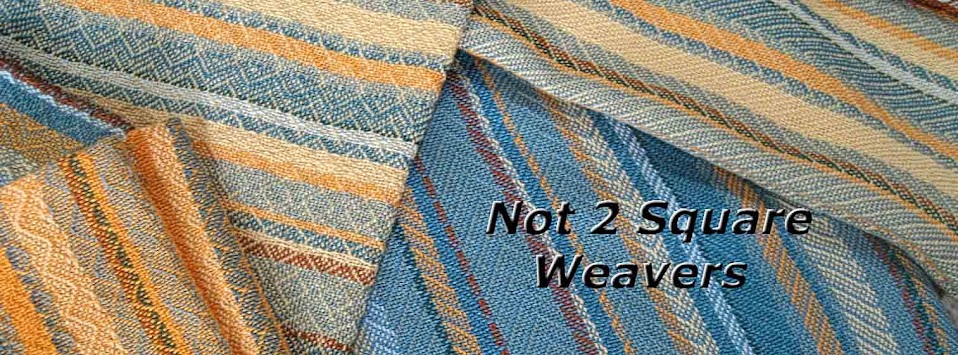We met for the first time at Kerry's studio at her Alpaca Ranch Kerry also sells yarns and equipment, so there was a lot to see before we settled into the meeting.
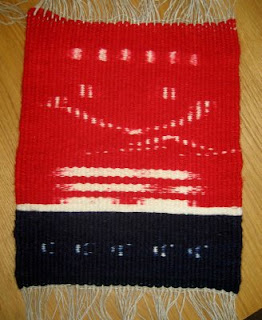
Kerry brought out a weft ikat sample that she did in a workshop with Mary Zikafoose. The pattern is planned and the yarn resisted and dyed so that color changes will fall into a pattern as it is woven. It is hard to get the pattern to fall exactly where you planned and Kerry says that you need to constantly adjust your weft yarns as you weave.
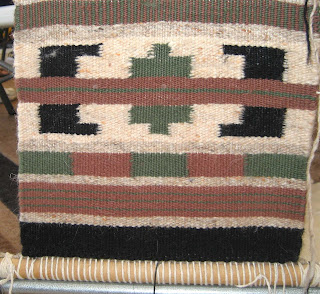
Kerry is working on this Navajo style tapestry in her studio. The work is beautiful -- but oh, so slow to weave. Below is a shot of the small loom she is using. We asked Kerry if she sat on the floor as she wove -- but no, she places the loom on a table and sits in a chair. Well, I guess we didn't really expect her to be that authentic in her weaving style!

Diana told us about her Theo Moorman inlay place mats at our last meeting. Now, she has woven four of them and says the process has become much more intuitive for her. With images all marked for each item in the place setting, Diana hopes they will help her young granddaughter learn how to set the table. With the assistance of a cartoon, Diana managed to get the plate and glass markings woven into almost perfect circles. Great job! If you are lucky enough to have the a collection of old Handwoven magazines, the directions are in the Sept/Oct 1992 issue on page 35.
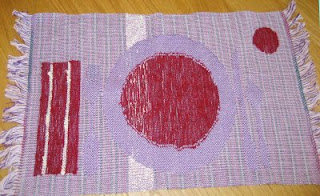
Carol came back full of news about the CNCH conference that was held in Sonoma this year. She took a class called "Oh, Dry Up" with weaver, Joanne Tallarovic. The class covered Swedish towel structures and techniques. The samples below are woven in a rep weave technique. The warp and weft are 8/2 cotton and the tie down weft is sewing thread. I believe this is a two block design. A thorough explanation of the process is in Joanne's book Rep Weave and Beyond

Carol came back from her class with a big binder full of samples and drafts for future reference. The green and white sample below is false damask. When this is woven in multiple colors, there is a wonderful ribbon effect of colors going over and under one another. On my list to try!

Jackie has a stash of 16/2 cotton and thought she would kill two birds with one stone. Get rid of
some of her fine thread stash and weave yardage for a lightweight top. She found an interesting draft in Carol Strickler's book of 8 shaft patterns and once weaving was underway, she discovered that it was going to be a textured piece of cloth. There are two similar value colors of thread so enlarge the picture so you can see it a bit better.

I have playing around with designing tie ups that will give a mock lace effect on a non-lace threading. In trying to explain myself at the meeting, I found I wasn't able to convey what I do to get a lacey effect by altering a twill tie up. I promised to put a draft together that would illustrate what I meant. Below you see a twill tie up that has little white and black crosses in it. These can be added or subtracted however you like in any twill tie up. In the drawdown, you see these little crosses appear in the cloth. The threading in this draft could be mirrored and repeated for an interesting design and treadling could be straight, point or tromp as writ.

Here is an example of a mock lace tie up for 20 shafts. The larger version makes it easier to see where I have added black and white crosses in the tie up. It is similar (but not identical) to the tie up I used for the shawl below.

Kerry brought out a weft ikat sample that she did in a workshop with Mary Zikafoose. The pattern is planned and the yarn resisted and dyed so that color changes will fall into a pattern as it is woven. It is hard to get the pattern to fall exactly where you planned and Kerry says that you need to constantly adjust your weft yarns as you weave.

Kerry is working on this Navajo style tapestry in her studio. The work is beautiful -- but oh, so slow to weave. Below is a shot of the small loom she is using. We asked Kerry if she sat on the floor as she wove -- but no, she places the loom on a table and sits in a chair. Well, I guess we didn't really expect her to be that authentic in her weaving style!

Diana told us about her Theo Moorman inlay place mats at our last meeting. Now, she has woven four of them and says the process has become much more intuitive for her. With images all marked for each item in the place setting, Diana hopes they will help her young granddaughter learn how to set the table. With the assistance of a cartoon, Diana managed to get the plate and glass markings woven into almost perfect circles. Great job! If you are lucky enough to have the a collection of old Handwoven magazines, the directions are in the Sept/Oct 1992 issue on page 35.

Carol came back full of news about the CNCH conference that was held in Sonoma this year. She took a class called "Oh, Dry Up" with weaver, Joanne Tallarovic. The class covered Swedish towel structures and techniques. The samples below are woven in a rep weave technique. The warp and weft are 8/2 cotton and the tie down weft is sewing thread. I believe this is a two block design. A thorough explanation of the process is in Joanne's book Rep Weave and Beyond

Carol came back from her class with a big binder full of samples and drafts for future reference. The green and white sample below is false damask. When this is woven in multiple colors, there is a wonderful ribbon effect of colors going over and under one another. On my list to try!

Jackie has a stash of 16/2 cotton and thought she would kill two birds with one stone. Get rid of
some of her fine thread stash and weave yardage for a lightweight top. She found an interesting draft in Carol Strickler's book of 8 shaft patterns and once weaving was underway, she discovered that it was going to be a textured piece of cloth. There are two similar value colors of thread so enlarge the picture so you can see it a bit better.

I have playing around with designing tie ups that will give a mock lace effect on a non-lace threading. In trying to explain myself at the meeting, I found I wasn't able to convey what I do to get a lacey effect by altering a twill tie up. I promised to put a draft together that would illustrate what I meant. Below you see a twill tie up that has little white and black crosses in it. These can be added or subtracted however you like in any twill tie up. In the drawdown, you see these little crosses appear in the cloth. The threading in this draft could be mirrored and repeated for an interesting design and treadling could be straight, point or tromp as writ.

Here is an example of a mock lace tie up for 20 shafts. The larger version makes it easier to see where I have added black and white crosses in the tie up. It is similar (but not identical) to the tie up I used for the shawl below.
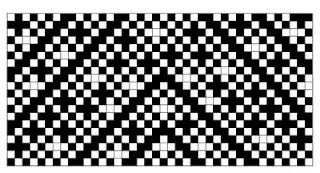

Next month we are finally going to have our napkin exchange. Some of us are done weaving our napkins -- and some have found spring pulling us into our gardens doing other fun stuff. See everyone in June!
